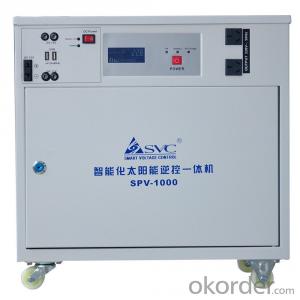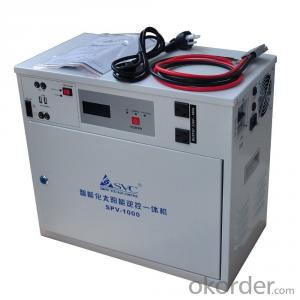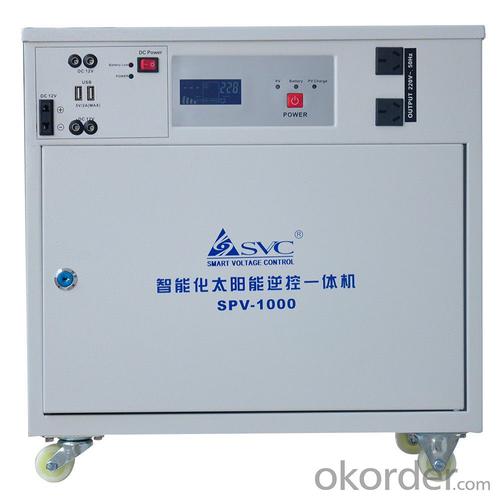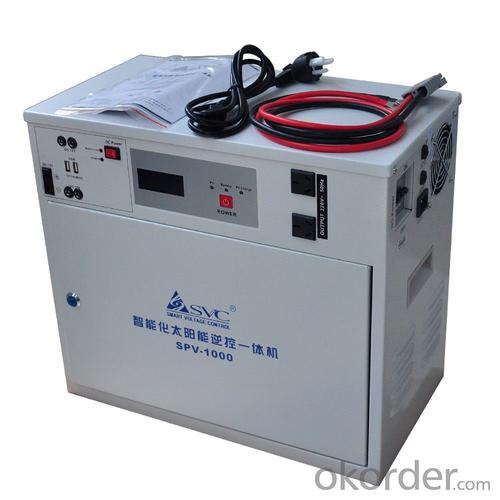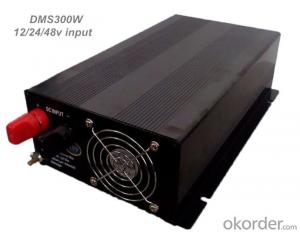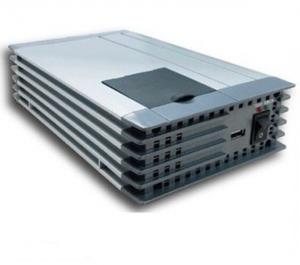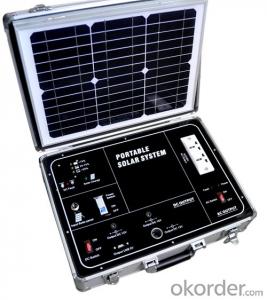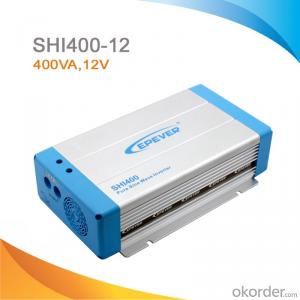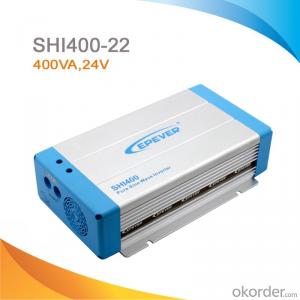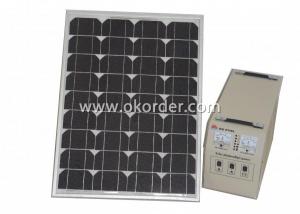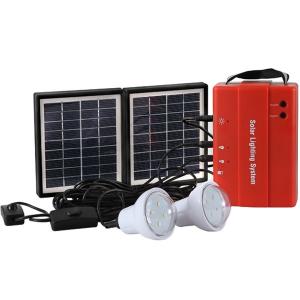Sun Solar Energy Systems - Pure Sine Wave LCD/LED AC/DC 360W Solar Power System
- Loading Port:
- China main port
- Payment Terms:
- TT OR LC
- Min Order Qty:
- 20 carton
- Supply Capability:
- 10000 carton/month
OKorder Service Pledge
OKorder Financial Service
You Might Also Like
ALL-IN-ONE 360W Pure Sine Wave AC/DC Output LCD/LED 12V/24V Solar Power System

| Model | SPV-600 | SPV-800 | SPV-1000 | SPV-1500 | |
| Rated power: | 360W | 480W | 600W | 1000W | |
| storage battery: | 12V(optional:24V) | ||||
| specifications of charging | |||||
| charging mode | PV charging and mains charging | ||||
| PWM solar controller: | voltage | 12V(optional:24V) | |||
| current | 30a(Max)(depends on the power of solar panels) | ||||
| PV maximm voltage | 12V system(potional:24V system) | ||||
| 25V | |||||
| hybrid charging | PV charging current:when I>15A,AC charging current is off | ||||
| PV charging current:when I>15A,AC charging current is 5A | |||||
| PV charging current:when I≤15A,AC charging current is 10A | |||||
| DC output system | |||||
| Charging port /USB | 5V/2A(Total)/ 2 units | ||||
| output port of DC | 12V/1.5A/ 3 units | ||||
| AC Mode | |||||
| Input voltage | 145-275VAC | ||||
| Input frequency | 48-54Hz(50HZ),Same s AC | ||||
| Output voltage | 200-240VAC | ||||
| Short Circuit | Breaker | ||||
| Inverter Mode | |||||
| Output voltage | 220VAC±5% | ||||
| Output frequency | 50±1% Hz(Auto detection) | ||||
| Output P.F | ≥0.6 | ||||
| Output wave form | Pure Sine Wave | ||||
| Transfer time | Typical 2-6ms,10ms max | ||||
| Overload capability | 110% Shut down within 60sec. | ||||
| 120% Shut down within 5sec. | |||||
| Short Circuit | ≥20ms System shut down automatically | ||||
| priority principle of mains and inversion | intelligent and automatic recongnition | ||||
| protection | protectings of output overload,output short circuit,inpot over voltage,input under voltage and over-temperature | ||||
| specifications of the overall unit | |||||
| dimension(mm) | 455*250*400 | ||||
| Net weight(KG) | 11 | 12 | 14 | 16 | |
| Gross weight(KG) | 12.5 | 13.5 | 16 | 18.5 | |
| display | display mode | LCD+LED | |||
| display information | LCD:working and protection status of inerter,charging status of storage battery | ||||
| LED:indications of working status and PV charging | |||||
| ENVIRONMENT | |||||
| ENVIRONMENT | indoor,or outdoor with waterproof measures | ||||
| Environment of performance: | Temperature 0℃~40℃,Humidity 20%~90%,non condensing | ||||
| Noise Level | Less than 40dB(lm) | ||||
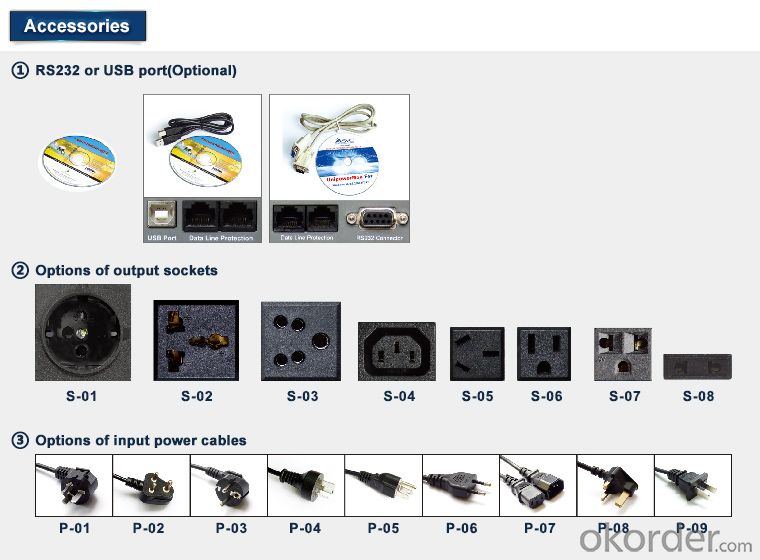

1. Wide range of input voltage
The UPS can offer normal and stable service voltage under its input voltage range. When the input voltage is out of its range the machine will switch to battery mode automatically to keep the output power in order to protect the equipment, such as computers, ensure they will not be damaged by the over high or over low voltage, users can continue the operation of equipment for a while or save the data on computers while the power network is abnormal.
2. Wide range of AVR(Automatic voltage regulation)
In the product’s input voltage range and under 3 steps of intelligent AVR function, it can provide a stable output voltage.
3. Automatic self detection when UPS on(LED).
Before the UPS on, red, yellow, blue LED will light up two times by cycle turns, after self detection UPS switch to AC mode/battery mode or working mode.
4. Silence function
In the "battery mode", shortly press the switch to turn off the buzzer. But the battery is about to run out or the load is too heavy, the buzzer sound cannot be muted.
5. Overload protection
In the battery mode, output voltage turn down correspondingly when it is overload, after the capacity of load is lower than the rated power then output voltage will back to rated value, it ensures the UPS will not shut down by abrupt overload which caused by surging current during the computer is working and other equipment is added.
6. Short circuit protection
When the mis-operation caused the load short circuit or computer failure (such as power tube breakdown of switch) cause short circuit, the UPS will shutdown automatically for protection.
7. The low current switch
This UPS adopts low current switch to extend the service life which is longer than conventional battery and high current switch in AC current path.
8. Automatic charging
There are two charging mode, charging time is faster than ordinary charging mode, higher efficiency, and greatly prolonging the service life of the battery.
9. With a bypass output
Independent bypass output socket for external printers or scanners of computer peripherals, with surge protection of the load.
- Q: What is the role of solar energy forecasting in grid integration?
- The role of solar energy forecasting in grid integration is vital for effectively managing the integration of solar power into the electrical grid. Solar energy forecasting provides accurate predictions of solar power generation, enabling grid operators and energy market participants to plan and optimize the operation of the grid. Solar energy is intermittent and variable, as it depends on weather conditions and the position of the sun. Therefore, accurate forecasting of solar power generation helps grid operators to anticipate fluctuations in solar energy supply and plan for potential imbalances between supply and demand. Grid integration of solar energy requires balancing the variability of solar power generation with the overall electricity demand. Solar energy forecasting plays a critical role in this process by providing real-time predictions of solar output, allowing grid operators to adjust other sources of power generation or storage to maintain grid stability. Moreover, solar energy forecasting is essential for the effective utilization of solar power in energy markets. Accurate forecasts enable energy market participants to optimize their trading strategies, determine the optimal dispatch of power generation assets, and manage their portfolio effectively. This helps to reduce the cost of integrating solar energy into the grid and enhances the overall economics of renewable energy. Additionally, solar energy forecasting contributes to the efficient operation of grid infrastructure. By providing accurate predictions of solar power generation, grid operators can plan the deployment and operation of transmission and distribution infrastructure, ensuring that it can handle the increasing penetration of solar energy without compromising grid reliability. Overall, solar energy forecasting plays a crucial role in grid integration by providing accurate predictions of solar power generation, allowing grid operators and energy market participants to effectively manage the integration of solar energy into the electrical grid, optimize energy trading strategies, maintain grid stability, and efficiently operate grid infrastructure.
- Q: Can solar energy systems be used for powering remote cabins or cottages?
- Yes, solar energy systems can be effectively used for powering remote cabins or cottages. Since these locations are typically situated far away from utility power grids, solar panels can harness sunlight and convert it into usable electricity to meet the energy needs of these off-grid properties. With advancements in solar technology, it is now possible to design systems that can generate enough power to run appliances, lighting, heating, and other electrical devices in remote cabins or cottages. Additionally, energy storage solutions like batteries can be integrated into the system to ensure a constant power supply even during periods of low sunlight.
- Q: How does solar energy compare to other renewable energy sources like wind or hydro power?
- Solar energy is a highly versatile and accessible renewable energy source that offers several advantages compared to other sources like wind or hydro power. Solar energy has a wide range of applications, from residential to commercial and industrial, making it more accessible and suitable for diverse needs. Unlike wind or hydro power, solar energy does not require specific geographic conditions or large infrastructure, making it easier to implement in various locations. Additionally, solar panels have a longer lifespan and require less maintenance compared to wind turbines or hydroelectric plants. However, solar energy is dependent on sunlight availability, which can vary by location and time of day, whereas wind and hydro power are less affected by these factors. Ultimately, the choice between solar, wind, or hydro power depends on specific circumstances and the energy needs of a particular area.
- Q: Can solar energy systems be used in areas with limited access to solar energy system financing options?
- Yes, solar energy systems can still be used in areas with limited access to solar energy system financing options. There are alternative financing options available such as leasing or power purchase agreements (PPAs) where the upfront costs are covered by third-party investors or companies. Additionally, government incentives and grants can help make solar energy systems more affordable in these areas.
- Q: Can solar panels be used to power agricultural irrigation systems?
- Yes, solar panels can be used to power agricultural irrigation systems. Solar panels can generate electricity that can then be used to power pumps, motors, or other equipment needed for irrigation systems. This helps reduce reliance on traditional energy sources and can make irrigation more sustainable and cost-effective for farmers.
- Q: How does temperature affect the efficiency of solar panels?
- Temperature affects the efficiency of solar panels by reducing their overall performance. As the temperature increases, the efficiency of solar panels decreases because the heat can cause the semiconductor material within the panel to have higher resistance, resulting in a reduced electrical output. This phenomenon, known as the temperature coefficient, varies depending on the type of solar panel technology being used.
- Q: Can a solar energy system be installed on a flat roof?
- Yes, a solar energy system can be installed on a flat roof. In fact, flat roofs are often considered ideal for solar panel installations due to their ease of access and unobstructed sunlight exposure. Flat roofs provide a relatively straightforward installation process as the panels can be mounted directly on the surface without the need for additional structural modifications. Additionally, the orientation and tilt of the solar panels can be optimized to maximize energy production. However, it is important to consider factors such as the load-bearing capacity of the roof, available space, and potential shading issues when planning the installation. Consulting with a professional solar installer or engineer can help ensure a successful installation on a flat roof.
- Q: What is the impact of temperature on the efficiency of a solar energy system?
- The efficiency of a solar energy system is significantly impacted by temperature. As the temperature increases, the efficiency of solar panels decreases. This is due to the behavior of the semiconductor materials used in solar cells. When solar panels are exposed to sunlight, they absorb photons and convert them into electricity. However, as the temperature rises, the resistance of the semiconductor material increases, leading to a decrease in the flow of current. This phenomenon is known as the temperature coefficient of power. The temperature coefficient of power is usually expressed as a percentage per degree Celsius and varies depending on the type of solar panel technology. Most solar panels have a negative temperature coefficient, meaning their efficiency decreases as the temperature rises. On average, the efficiency of solar panels can decrease by around 0.5% to 0.8% per degree Celsius increase in temperature. Additionally, increased temperatures can also cause thermal losses within the system. Heat can build up within the solar panels, reducing their efficiency further. This is especially true in hot climates or during periods of high solar irradiance. To mitigate the impact of temperature on solar energy system efficiency, various strategies can be employed. One common method is to incorporate cooling mechanisms, such as ventilation or water circulation, to dissipate the excess heat generated by the solar panels. This helps maintain lower operating temperatures and consequently improves the overall efficiency. Furthermore, proper system design and installation techniques can also help minimize temperature-related losses. For example, mounting solar panels with sufficient spacing to allow for air circulation can prevent overheating. Additionally, selecting solar panels with lower temperature coefficients can help mitigate efficiency losses in high-temperature environments. In conclusion, temperature has a significant impact on the efficiency of a solar energy system. Higher temperatures can cause a decrease in the efficiency of solar panels, primarily due to increased resistance in the semiconductor materials. To optimize the performance of solar energy systems, strategies such as cooling mechanisms and proper system design should be implemented.
- Q: Can solar energy systems be installed in areas with extreme temperatures?
- Yes, solar energy systems can be installed in areas with extreme temperatures. However, the performance and efficiency of the system may be affected by the extreme temperatures. It is important to consider the specific climate conditions and adapt the system accordingly, such as using heat-resistant materials and proper cooling mechanisms.
- Q: Can solar energy systems be used for powering research laboratories?
- Yes, solar energy systems can definitely be used for powering research laboratories. Solar energy is a clean and renewable source of power that can be harnessed through photovoltaic (PV) panels or solar thermal systems. Research laboratories often require a significant amount of electricity to power various equipment, lighting, and ventilation systems, and solar energy can meet these energy demands effectively. Solar PV panels can be installed on the rooftop or open areas surrounding the laboratory to capture sunlight and convert it into electricity. This electricity can then be used to power the laboratory's infrastructure, including computers, microscopes, refrigeration units, and other specialized equipment. Additionally, excess electricity generated during the day can be stored in batteries or fed back into the grid for later use or to offset energy costs. Solar thermal systems, on the other hand, can be utilized to generate heat for laboratory processes that require heating, such as sterilization or chemical reactions. These systems use sunlight to heat a fluid, which can then be used directly or indirectly to provide heat to the laboratory. Implementing solar energy systems in research laboratories not only reduces the reliance on fossil fuels but also decreases greenhouse gas emissions and contributes to environmental sustainability. Moreover, it can lead to cost savings in the long term as solar energy is essentially free once the initial installation costs are recouped. However, it is important to consider the specific energy requirements of the research laboratory and conduct a comprehensive feasibility study before installing solar energy systems. Factors such as the laboratory's location, available sunlight, roof orientation, and space availability need to be taken into account to ensure optimal system performance. Additionally, the laboratory may need to have a backup power source or grid connection to ensure uninterrupted power supply during periods of low sunlight or high energy demand. Overall, solar energy systems are a viable and sustainable solution for powering research laboratories, providing clean and reliable energy to support scientific advancements.
Send your message to us
Sun Solar Energy Systems - Pure Sine Wave LCD/LED AC/DC 360W Solar Power System
- Loading Port:
- China main port
- Payment Terms:
- TT OR LC
- Min Order Qty:
- 20 carton
- Supply Capability:
- 10000 carton/month
OKorder Service Pledge
OKorder Financial Service
Similar products
Hot products
Hot Searches
Related keywords
